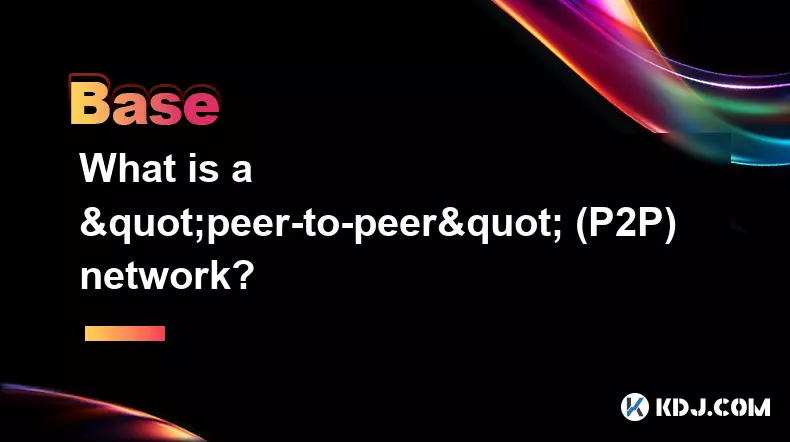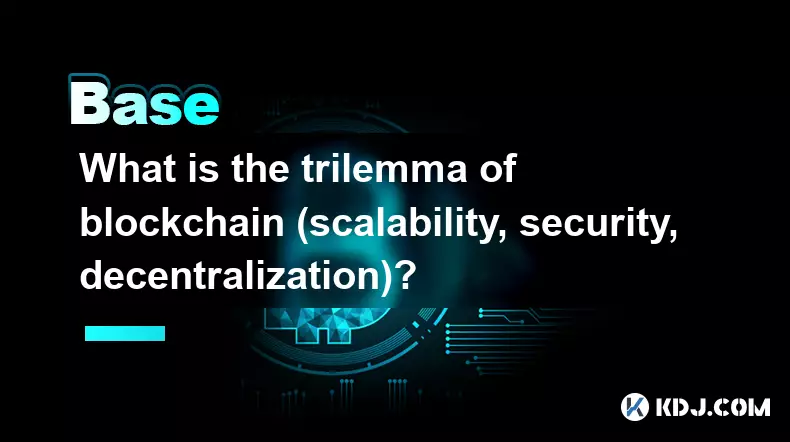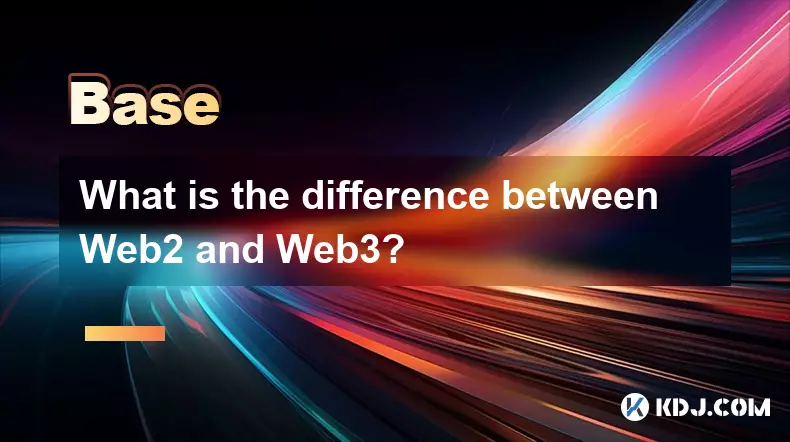-
 bitcoin
bitcoin $110047.851143 USD
-1.37% -
 ethereum
ethereum $3727.617466 USD
-1.30% -
 tether
tether $1.000961 USD
-0.05% -
 bnb
bnb $1114.045467 USD
1.72% -
 xrp
xrp $2.343280 USD
0.14% -
 solana
solana $174.674876 USD
-5.85% -
 usd-coin
usd-coin $0.999999 USD
0.02% -
 tron
tron $0.311757 USD
-2.44% -
 dogecoin
dogecoin $0.183678 USD
-3.76% -
 cardano
cardano $0.627109 USD
-2.07% -
 ethena-usde
ethena-usde $1.000300 USD
0.15% -
 hyperliquid
hyperliquid $36.865760 USD
-2.74% -
 chainlink
chainlink $16.968918 USD
-1.48% -
 stellar
stellar $0.318159 USD
0.47% -
 bitcoin-cash
bitcoin-cash $500.637224 USD
-1.56%
What is a "peer-to-peer" (P2P) network?
Peer-to-peer networks enable decentralized, secure cryptocurrency transactions by linking nodes that validate and synchronize blockchain data without central control.
Oct 12, 2025 at 04:54 am

Understanding Peer-to-Peer Networks in the Cryptocurrency Ecosystem
A peer-to-peer (P2P) network is a decentralized infrastructure where participants, known as nodes, share resources directly without relying on a central authority. In the context of cryptocurrency, P2P networks form the backbone of blockchain technology, enabling secure and transparent transactions between users across the globe.
How P2P Networks Support Blockchain Operations
1. Every node in a P2P network maintains a full or partial copy of the blockchain ledger, ensuring data consistency and integrity.2. When a new transaction is initiated, it is broadcasted across the network where multiple nodes validate its legitimacy based on consensus rules.
3. Miners or validators pick up these verified transactions, bundle them into blocks, and add them to the chain after solving complex cryptographic puzzles or through stake-based mechanisms.
4. Once confirmed, the updated block is propagated back through the P2P network, synchronizing all participating nodes with the latest state of the ledger.
5. This distributed validation process eliminates single points of failure and enhances resistance against censorship and cyberattacks.
The Role of Decentralization in Financial Autonomy
1. Users retain control over their private keys and digital assets without intermediaries such as banks or payment processors.2. Transactions occur directly between wallets, reducing processing fees and settlement times compared to traditional financial systems.
3. The absence of centralized oversight allows individuals in regions with restrictive monetary policies to access open financial tools.
4. Developers can build decentralized applications (dApps) on top of P2P blockchains, expanding use cases beyond simple value transfer to include lending, trading, and identity management.
5. Because no single entity governs the network, changes to protocol rules require broad agreement among stakeholders, promoting transparency and community-driven governance.
Security and Resilience in P2P Architectures
1. Distributed data storage makes it extremely difficult for malicious actors to alter historical records or execute double-spending attacks.2. Even if some nodes go offline or are compromised, the network continues operating through remaining healthy peers.
3. Encryption standards and digital signatures ensure that only rightful owners can initiate transfers from their addresses.
4. Sybil attacks are mitigated through economic incentives and consensus algorithms like Proof of Work or Proof of Stake.
5. Open-source codebases allow continuous auditing by independent developers, increasing trust and identifying vulnerabilities early.
Frequently Asked Questions
What happens if two conflicting transactions are broadcast at the same time?The network follows the longest valid chain rule in most blockchains. Nodes accept the version of the transaction included in the block that becomes part of the dominant chain, while the other is discarded or re-broadcast.
Can anyone join a cryptocurrency P2P network?Yes, most public blockchains are permissionless. Any individual with an internet connection and compatible software can download the protocol, run a node, and participate in transaction validation.
Do P2P networks consume a lot of energy?Energy consumption depends on the consensus mechanism. Proof of Work networks like Bitcoin require significant computational power, whereas Proof of Stake systems drastically reduce energy usage by replacing mining with staking.
How do nodes discover each other in a P2P network?New nodes typically connect to seed nodes—predefined addresses hardcoded into the client software. From there, they receive lists of active peers and maintain connections dynamically using network discovery protocols.
Disclaimer:info@kdj.com
The information provided is not trading advice. kdj.com does not assume any responsibility for any investments made based on the information provided in this article. Cryptocurrencies are highly volatile and it is highly recommended that you invest with caution after thorough research!
If you believe that the content used on this website infringes your copyright, please contact us immediately (info@kdj.com) and we will delete it promptly.
- XRP Price Prediction: Weekend Rollercoaster or Rally?
- 2025-10-12 08:45:16
- Bittensor (TAO): Super Bullish Signals Point to Potential 2x Rally
- 2025-10-11 10:25:12
- Silver Price Correction: Navigating the Dip & Identifying Key SEO Keywords
- 2025-10-11 10:25:12
- Decoding Crypto Trends: Bittensor's Bull Run, Cardano's Dip, and LivLive's Presale Buzz in 'Uptober 2025'
- 2025-10-12 08:45:16
- MoonBull: The Crypto Meme Coin Promising 1000x Gains?
- 2025-10-11 10:30:01
- Crypto Payroll Revolution: Stablecoins, Altcoins, and the Future of Salary Payments
- 2025-10-11 10:30:01
Related knowledge

What does it mean for code to be "open source" in crypto?
Oct 12,2025 at 01:54pm
Understanding Open Source in the Cryptocurrency Ecosystem1. In the context of cryptocurrency, open source refers to software whose code is publicly ac...

What is the purpose of a "testnet"?
Oct 12,2025 at 09:01am
Understanding the Role of Testnets in Blockchain Development1. A testnet serves as a parallel version of a blockchain network, designed specifically f...

What is the difference between single-collateral and multi-collateral Dai?
Oct 12,2025 at 05:18pm
Understanding Single-Collateral Dai1. Single-Collateral Dai (SCD) was the original version of the Dai stablecoin launched by MakerDAO in 2017. It allo...

What is "EIP-1559" and how did it change Ethereum?
Oct 12,2025 at 03:00am
Understanding EIP-1559 and Its Core Mechanism1. EIP-1559 is a protocol upgrade introduced to the Ethereum blockchain as part of the London hard fork i...

What is the trilemma of blockchain (scalability, security, decentralization)?
Oct 11,2025 at 10:36am
Understanding the Blockchain TrilemmaThe blockchain trilemma is a concept that highlights the inherent challenge in simultaneously achieving three cor...

What is the difference between Web2 and Web3?
Oct 11,2025 at 03:19pm
Understanding the Structural Shift from Web2 to Web31. Web2 is characterized by centralized platforms where large corporations control user data, cont...

What does it mean for code to be "open source" in crypto?
Oct 12,2025 at 01:54pm
Understanding Open Source in the Cryptocurrency Ecosystem1. In the context of cryptocurrency, open source refers to software whose code is publicly ac...

What is the purpose of a "testnet"?
Oct 12,2025 at 09:01am
Understanding the Role of Testnets in Blockchain Development1. A testnet serves as a parallel version of a blockchain network, designed specifically f...

What is the difference between single-collateral and multi-collateral Dai?
Oct 12,2025 at 05:18pm
Understanding Single-Collateral Dai1. Single-Collateral Dai (SCD) was the original version of the Dai stablecoin launched by MakerDAO in 2017. It allo...

What is "EIP-1559" and how did it change Ethereum?
Oct 12,2025 at 03:00am
Understanding EIP-1559 and Its Core Mechanism1. EIP-1559 is a protocol upgrade introduced to the Ethereum blockchain as part of the London hard fork i...

What is the trilemma of blockchain (scalability, security, decentralization)?
Oct 11,2025 at 10:36am
Understanding the Blockchain TrilemmaThe blockchain trilemma is a concept that highlights the inherent challenge in simultaneously achieving three cor...

What is the difference between Web2 and Web3?
Oct 11,2025 at 03:19pm
Understanding the Structural Shift from Web2 to Web31. Web2 is characterized by centralized platforms where large corporations control user data, cont...
See all articles









































































